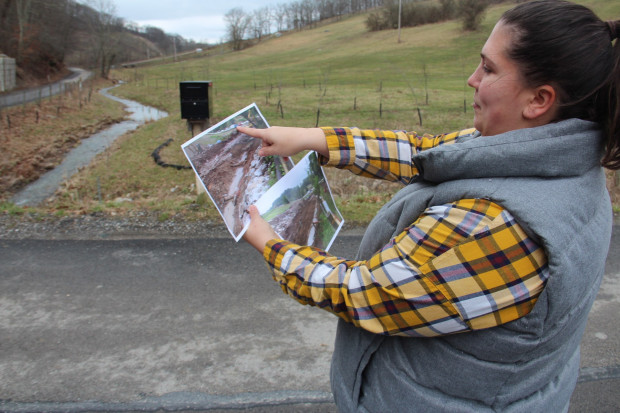Congress axed a rule to protect streams from coal pollution. Here’s what that means for Pennsylvania
-
Reid Frazier/The Allegheny Front

Reid Frazier / The Allegheny Front
Veronica Coptis shows pictures of the reconstruction of Polen Run, a Greene County stream undermined by Consol Energy.
Among the first accomplishments of the new Congress was undoing a regulation barely one month old — the Department of Interior’s Stream Protection Rule.
The agency finalized the rule in December, in one of the Obama administration’s final acts. But using a law called the Congressional Review Act, the new Congress quickly voted to take back the new rule, which would have made it harder for mining companies to bury or discharge mining waste in streams.
Coal companies said the rule would have jeopardized their already struggling industry. But just how would it have affected mines? One clue can be found up a wooded ravine in Greene County.
In Ryerson Station State Park, Veronica Coptis, of the Center for Coalfield Justice, shows off a warm-water trout stream called Kent Run. It’s a typical western Pennsylvania run, coursing off a hillside through a hardwood forest.
“It’s really pristine,” Coptis says. “It’s a beautiful place — it’s even more gorgeous in the summer.”
The stream runs right above Consol Energy’s Bailey Mine, the largest producing underground mine in North America. Consol had planned to mine beneath Kent Run, but Coptis’ group — along with the Sierra Club — stopped that plan, at least for now. The groups appealed Consol’s mining permit, and a state environmental hearing board judge sided with them — blocking Consol from mining within 100 feet of the stream. The judge called the Department of Environmental Protection’s permitting process for the mine “arbitrary, capricious, inappropriate and unreasonable.”
Consol recently announced 200 miners would be temporarily laid off because of the order. In court records, the company said it stood to lose $15.3 million because of the decision, as it would have to leave 360,000 tons of coal in the ground.
The groups opposed the permit because they feared mining beneath the stream could cause subsidence, which could lead to cracks in the streambed. When this happens, water can pool or run into these cracks and dry up the stream. Between 2008 and 2013, 39 miles of streams and 855 wells, springs and ponds in Pennsylvania suffered subsidence effects, according to a state tally.
Coptis says she doesn’t want it to happen in Kent Run. “We’re trying to prevent any significant subsidence, damage or cracking in the stream bank. We’re worried about the loss of springs that are feeding the stream water.”
Consol and the DEP argued that the company would be able to fix the streambed by pouring cement in any cracks that opened up; or — if that didn’t work — by rebuilding the stream entirely. Consol spokesman Brian Aiello said in an email that state law “clearly allows for” mining beneath streams and “outlines a process by which mining and protecting the environment can coexist. This is why we believe the EHB decision is wrong and why we are aggressively appealing it.”
While that case moves forward in state courts, Coptis and other environmentalists were hoping they would soon get help from the federal government on issues of water pollution from mining. The Stream Protection Rule would have tightened requirements for companies through more rigorous permitting, water monitoring and stream restoration requirements.
“In laymen’s terms, they’d have to assure [that] they’re not going to ruin water quality downstream, and restore the impacted streams to some reasonable form and function,” says Erin Savage of the environmental group Appalachian Voices.
The rule was initially designed to address the impacts of mountaintop removal, a type of mining common in Central Appalachia, which has buried over 1,200 miles of rivers and streams. Environmental groups were generally lukewarm on the rule, though, since it would have allowed the practice to continue.
“It was a moderate rule — it wasn’t some sort of drastic tree-hugger rule,” Savage says. “It was updating an existing rule based on current science.”
But the mining industry vigorously opposed the rule, and the Republican-controlled Congress wasted little time dispatching it. Bill Johnson, the southeast Ohio GOP congressman who co-sponsored legislation repealing the rule called it “an effort to regulate the coal mining industry right out of business.”
Rachel Gleason, executive director of the Pennsylvania Coal Alliance, says the rule was overly broad and, despite the fact that it was aimed originally at surface mining, could have been used to regulate underground “longwall” mining, a common technique used in Pennsylvania.
“They expanded it to areas it should not be expanded to,” Gleason says. “It’s a one-size-fits-all for the entire nation; that does not work.” Gleason says states like Pennsylvania should be allowed to regulate stream rules for the mining industry. “We should be able to do that on the state level and not have a one-size approach for Pennsylvania that also applies to Wyoming. It’s not the same geology; it’s not the same topography.”
Gleason says her group was worried that in Pennsylvania, the Stream Protection Rule would have restricted the ability of coal companies to mine beneath streams, and that would have made it virtually impossible to mine coal economically in Pennsylvania. “Given the hydrology and makeup of Pennsylvania — its peaks and valleys and hills — it would be very difficult.” She says that would cost the state thousands of jobs and billions of dollars in lost economic activity.
Aiello, the Consol spokesman, said the Stream Protection Rule was an “ill-conceived concept” and that “the voters in November rejected the brand of ideology that was driving it.”
The Center for Coalfield Justice’s case against Consol is headed to a state appeals court.
Note: This story is from the Allegheny Front, a public radio program covering environmental issues in Western Pennsylvania, airing on WESA in Pittsburgh and on stations throughout the region.
















